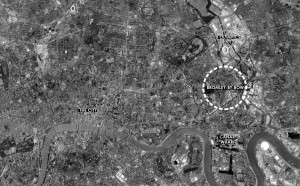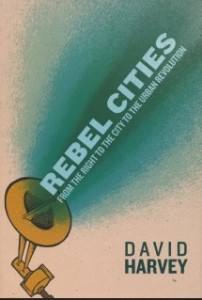OC 50: East London Transformations
After the games
Now that the London Olympic Games have closed their doors and a fence has been re-erected around the whole site it may be a good time to reflect on what urban transformations lie in stall for the East End.

1_dia blue fence, poster for event by PNUK with Games Monitor
source: http://www.pnuk.org.uk/bluefence.htm
The third European Urban Summer School (EUSS), initiated by the Association of European Planning Schools <http://www.aesop-planning.eu/> had chosen an area, Bromley-by-Bow, on the fringe of this huge place of change to study what improvements urbanists could imagine for traditionally poor neighourhoods with very mixed communities.
Redressing London’s east-west imbalance
Trying to redress the imbalance between the rich west and the poor east of London is not new. Already Charles Booth had documented East London’s deprivation in his maps at the end of the 19th century. Planners at the London County Council had undertaken to address London’s spatial inequalities, notably in the plans for London by Patrick Abercrombie produced during 1944 and 1945.

3_dia Abercrombie social condition map
source: http://www.utopialondon.com/mm_uploads/communities_map.jpg
These were scarce but optimistic times and a lot of hope was pitched at a better future for the East End, across a vision of industrial production based on goods imported from the colonies and trade through one of the world’s largest port.

4_dia historic view of Port of London
source: http://captainjpslog.blogspot.co.uk/2009/09/100-years-of-port-of-london-authority.html
The future turned out rather different. It is tempting to draw a parallel with current visions for the impoverished East End and the hope that the legacy of the Olympic site and its surroundings will manage to shift London’s centre of gravity eastward, again in times of austerity, driven perhaps by slightly less optimism but more expectations from global investment.
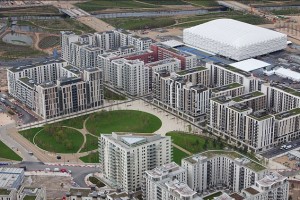
5a_dia Olympic village during games
source: http://www.archboston.org/community/showthread.php?p=155564
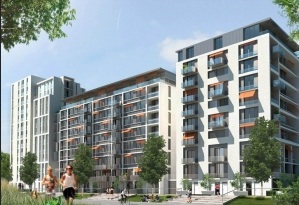
5b_dia Olympic village in the future
source: http://www.sportspromedia.com/news/london_olympic_village_investors_announced
Two contrasting scenarios
Winning the Olympic bid enabled London to invest enormous amounts of public money (officially £9.3 billion) to clear the Olympic site and add new infrastructure, turning Stratford East into one of the best connected transport hubs of London and making vast tracks of land available for development.
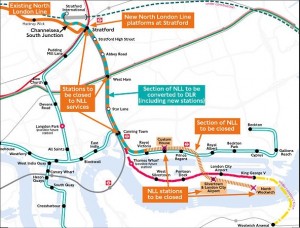
6_dia Stratford East London public transport connections
source: http://www.lcacc.org/access/index.html
The question for those who aim at social and spatial justice is how much of this bonanza will benefit the existing communities which have been displaced from the site or are living and working around the site. There are two opposing views. One claims a trickle down effect from such massive urban regeneration for all, the other maintains that such interventions increase physical as well as economic and social polarisation.
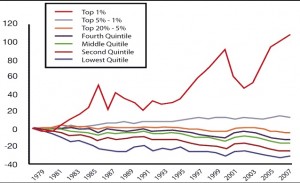
7a_dia trickle_down? US share of national income 1979-2008
source: http://www.newleftproject.org/index.php/site/article_comments/a_short_history_of_neoliberalism_and_how_we_can_fix_it

7b_dia three layers of human condition unchanged
source: http://blasphemes.blogspot.co.uk/2010_07_01_archive.html
The reality may lie somewhere in between, regeneration having its merits in so far as it valorises land and real estate otherwise deteriorating. However, gentrification occurring alongside it is a divisive phenomenon to the detriment of the weaker population. The tricky question is whether gentrification is a path-dependent consequence of regeneration, or whether there exist other, more inclusive development options which do not necessitate displacement of weaker populations and jobs and can create a genuinely mixed urban environment where people from different economic and cultural backgrounds manage to live alongside each other without conflict or confrontation.

8_dia multicultural neighbourhoods: Bromley by Bow festival
source: http://i.ytimg.com/vi/2YbmfF-fw3A/0.jpg
These questions are addressed by different agencies as well as academia, also by the EUSS summer school. Answers by planning authorities to human needs or equity considerations, in the London Plan for example, are subject to political positions and follow contrasting perceptions. The quota for genuinely affordable housing in London has all but disappeared and house price inflation, together with capped housing benefits are bound to increase housing segregation which may gradually price the poor out of London. Manhattan is showing the way, but London may well follow, unless alternative spatial strategies are being put forward at the local level. However, emaciation of local authority powers and resources leave little room for manoeuvre; similarly provisions of the Localism Act are more likely to be taken up by ‘nimbys’ than marginalised communities. Short of David Harvey’s vision of urban revolution in his Rebel Cities (2012, Verso) there is little chance for this trend to be reversed in the near future.

9b_dia Harvey speaking at Occupy London on 13 November 2011,
source: video http://article.wn.com/view/2012/04/30/Ahead_of_May_Day_David_Harvey_Details_Urban_ Uprisings_from_O_9/

